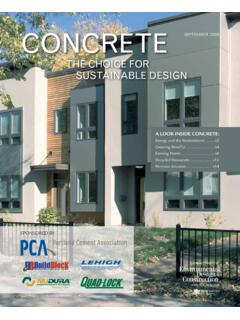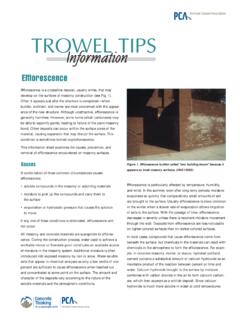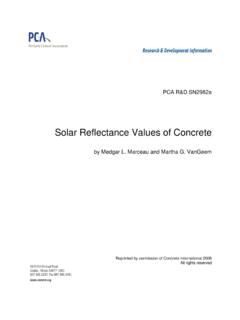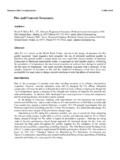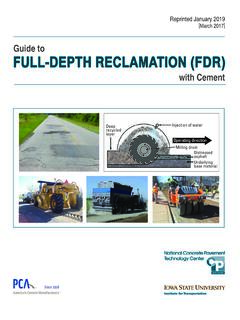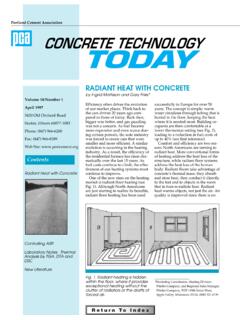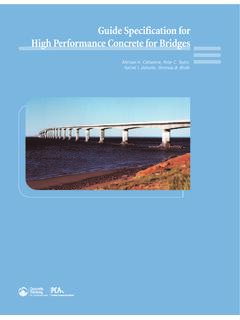Transcription of Portland Cement Association TROWEL TIPS …
1 Portland Cement Association TROWEL tips . INFORMATION. an aid to the masonry industry Field Testing Masonry Mortar With the exception of masonry constructed in seismic zones, field testing of masonry has generally been limited to an occasional evaluation of masonry mortar. More frequently than not, even this testing is done improperly and interpreted incorrectly, resulting in needless contro- versy and waste. As ACI 530/ASCE 5/TMS 402 (Building code Requirements for Masonry Structures ) and ACI 6/TMS 602 (Specification for Masonry Structures ) requirements for quality assurance are imple- mented into construction documents, field testing of masonry components and assemblies will become more commonplace.
2 Specifiers, contractors, and project inspec- tors need to be familiar with the testing procedures and understand the meaning of laboratory and field results. Field testing of mortar is included in project specifications as a quality control measure. Properly conducted, it must involve preparation prior to construction. The contractor selects the ingredients and the mix design in accordance with the project specifications. A preconstruction evalua- tion of mortar is conducted to develop data that serves as a benchmark for future evaluation of mortar produced during construction.
3 The testing is to be conducted in accordance with the Standard Test Method for Preconstruction and Construction Evaluation of Mortars for Compressive strength of mortar is only one of several important Plain and Reinforced Unit Masonry (ASTM C780) and mortar properties. should be performed by an accredited laboratory conform- Compressive strength is only one of several important ing to the Standard Practice for the Accreditation of Testing mortar properties. Workability and water retentivity Agencies for Unit Masonry (ASTM C1093).
4 As stated in often have a greater impact on the quality of the Article of the Commentary on Specification for Ma- masonry constructed. Other properties such as shrink- sonry Structures (ACI 6/TMS 602) ASTM age characteristics and resistance to freeze-thaw de- C270 specifies mortar testing under laboratory condi- terioration can also affect the long term performance tions only for acceptance of mortar mixes under the of the masonry. property specification. Field sampling and testing of Field test results of compressive strength of mortar do mortar is conducted under ASTM C780 and is used to not represent laboratory mortar strengths and are not verify consistency of materials and procedures, not required or expected to meet ASTM C270 property mortar strength.
5 Specification limits. Unfortunately, the preconstruction evaluation is often Performance requirements for masonry mortar cannot omitted and many times laboratory field technicians do not be equated to those for concrete. use ASTM C780 testing procedures properly. These Field test results of compressive strength of mortar are deficiencies, compounded by misunderstanding of the not representative either of in-place compressive significance of mortar test results by project inspectors and strength of the mortar or in-place compressive strength engineers, often produce needless and costly construction of the masonry.
6 Delays. Sometimes unwarranted corrective measures Field test results of compressive strength of mortar are are taken that further escalate costs. These problems can dependent on several variables. These include test be avoided if all involved understand the following basic procedures and test conditions in addition to propor- concepts with respect to the performance of masonry: tions and properties of mortar materials. Portland Cement Association 1997. Mortar mixed to a laboratory flow consistency of 110 5. percent as required for determination of compressive strength according to ASTM C270.
7 Property requirements (illustrated top left and bottom left) approximates the consistency of mortar after it has been in contact with absorptive masonry units. Mortar mixed to a workable consistency suitable for construction (top right and bottom right). has a flow that is much higher often over 130. percent. Compressive strength tests of mortar mixed to that higher job flow consistency are not required to meet the strength minimums of the property specifications of ASTM C270. can have an adverse effect on the completed masonry.
8 For Masonry Mortar Performance this reason changes to mortar mix designs should not be based on field test results of compressive strength. Requirements The need for changes in mix design should be confirmed by Comparisons between masonry mortars and concrete are laboratory controlled tests or a combination of laboratory often misleading. While these materials have some similar and field tests. ingredients, their structural properties differ. Materials and methods that produce strong and durable concrete do not necessarily produce mortar or masonry of similar quality.
9 Field Test Procedures As an example, it is recognized that high strength con- ASTM C780 outlines several test procedures for measur- crete requires a low water- Cement ratio. Conversely, ing various properties of field sampled mortar. Each quality masonry mortar requires comparatively higher wa- procedure is listed as a separate annex to the standard, as ter- Cement ratios during placement. Higher water content indicated in Table 1. Annex A9 outlines a report form is necessary for workability and to satisfy the absorptive indicating the information to be recorded and reported for characteristics of the masonry units.
10 That high water each test procedure. content produces a workable mortar mix that readily flows Of the eight test procedures outlined, six are conducted into the irregular surfaces of masonry units assuring inti- on samples of the mortar while it is still in its plastic state. mate contact between mortar and unit. Since some of the Two, the compressive strength test and the splitting tensile mixing water is absorbed by the masonry unit, in-place strength test, are measures of hardened properties of mortar has a much lower water- Cement ratio than the mortar specimens prepared from plastic mortar samples.
